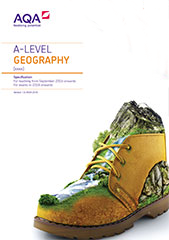3.1.4 Glacial systems and landscapes
This section of our specification focuses on glaciated landscapes. These are dynamic environments in which landscapes continue to develop through contemporary processes but which mainly reflect former climatic conditions associated with the Pleistocene era. The operation and outcomes of fundamental geomorphological processes and their association with distinctive landscapes are readily observable. In common with water and carbon cycles, a systems approach to study is specified.
Student engagement with subject content fosters an informed appreciation of the beauty and diversity of glaciated regions and the challenges they present for human habitation. The section offers the opportunity to exercise and develop observation skills, measurement and geospatial mapping skills, together with data manipulation and statistical skills, including those associated with and arising from fieldwork.
Glaciers as natural systems
Systems in physical geography: systems concepts and their application to the development of glaciated landscapes – inputs, outputs, energy, stores/components, flows/transfers, positive/negative feedback, dynamic equilibrium. The concepts of landform and landscape and how related landforms combine to form characteristic landscapes.
The nature and distribution of cold environments
The global distribution of cold environments.
Physical characteristics of cold environments. Climate, soils and vegetation (and their interaction).
The global distribution of past and present cold environments (polar, alpine, glacial and periglacial) and of areas affected by the Pleistocene glaciations.
Systems and processes
Glacial systems including glacial budgets.
Ablation and accumulation – historical patterns of ice advance and retreat.
Warm and cold based glaciers: characteristics and development.
Geomorphological processes – weathering: frost action, nivation; ice movement: internal deformation, rotational, compressional, extensional and basal sliding; erosion: plucking, abrasion; transportation and deposition.
Fluvioglacial processes: meltwater, erosion transportation and deposition.
Periglacial features and processes: permafrost, active layer and mass movement.
Glaciated landscape development
This content must include study of a variety of landscapes from beyond the UK and may also include UK examples.
Origin and development of glaciated landscapes.
Erosional and depositional landforms: corries, arêtes, glacial troughs, hanging valleys, truncated spurs, roches moutonnées. Characteristic glaciated landscapes.
Origin and development of landforms and landscapes of glacial deposition: drumlins, erratics, moraines, till plains. Characteristic glaciated landscapes.
Fluvioglacial landforms of erosion and deposition: meltwater channels, kames, eskers, outwash plains. Characteristic fluvioglacial landscapes.
Periglacial landforms: patterned ground, ice wedges, pingos, blockfields, solifluction, lobes, terracettes, thermokarst. Characteristic periglacial landscapes.
The relationship between process, time, landforms and landscapes in glaciated settings: characteristic glaciated and periglacial landscapes.
Human impacts on cold environments
Concept of environmental fragility. Human impacts on fragile cold environments over time and at a variety of scales. Recent and prospective impact of climate change. Management of cold environments at present and in alternative possible futures.
Quantitative and qualitative skills
Students must engage with a range of quantitative and relevant qualitative skills, within the theme landscape systems. These should include observation skills, measurement and geospatial mapping skills and data manipulation and statistical skills applied to field measurements.
Case studies
Case study(ies) of glaciated environment(s) at a local scale to illustrate and analyse fundamental glacial processes, their landscape outcomes as set out above and engage with field data.
Case study of a contrasting glaciated landscape from beyond the UK to illustrate and analyse how it presents challenges and opportunities for human occupation and development and evaluate human responses of resilience, mitigation and adaptation.
